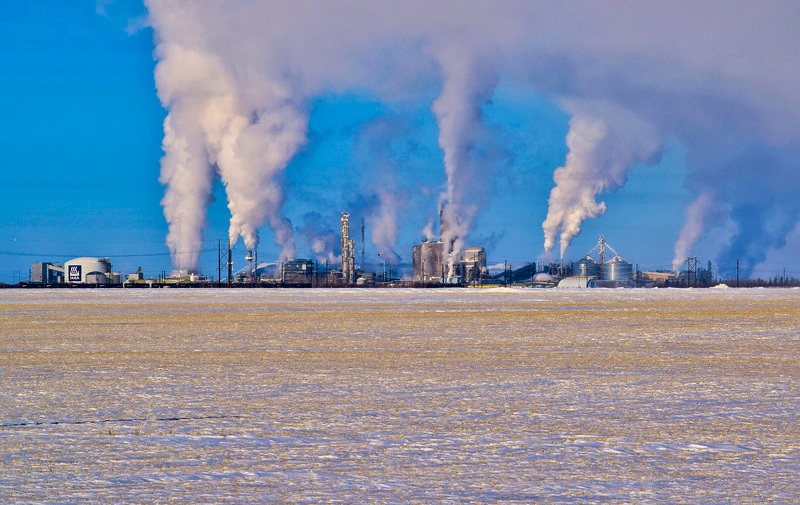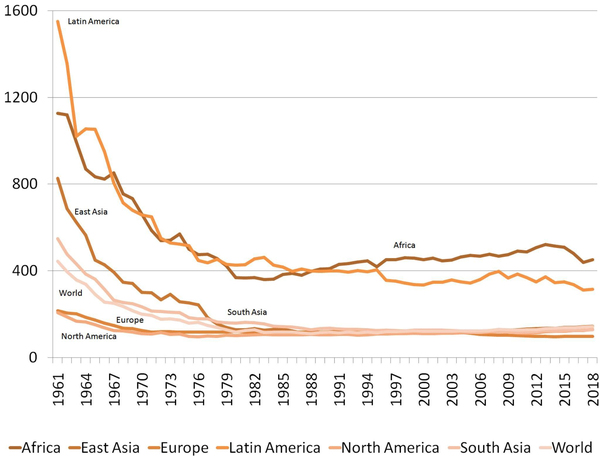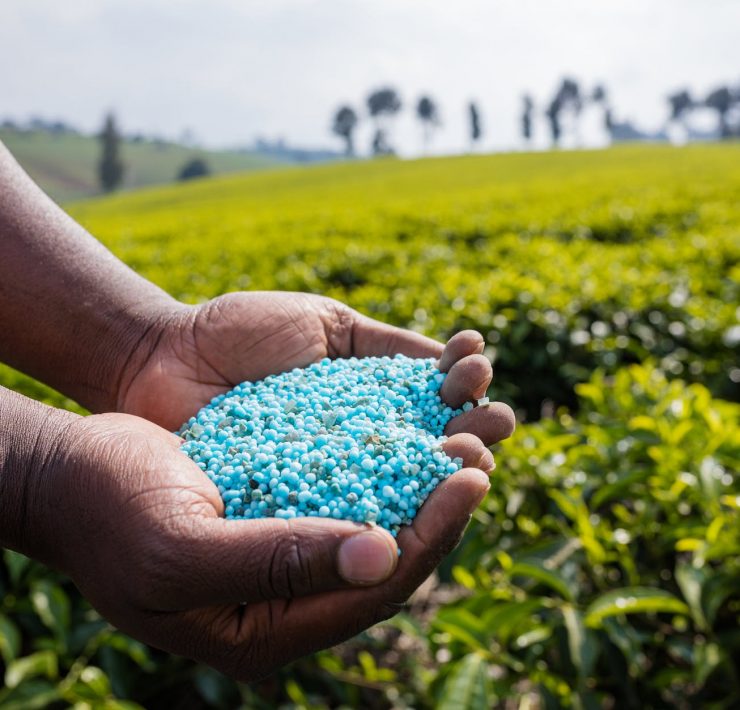
GRAIN is a small international non-profit organisation that works to…
Read Next
To Address The Climate Crisis
Originally published on Grain.org
The rising costs of synthetic nitrogen (N) fertilisers, triggered by a spike in natural gas prices, has governments panicking about a catastrophic global food crisis.[1] At the same time, new research shows that synthetic N fertilisers are a major driver of the climate crisis, responsible for 1 out every 40 tonnes of GHGs currently pumped into the atmosphere.[2] As the 26th UN Climate Change Conference gets underway, now is the time for the world to kick its addiction to synthetic N fertilisers and urgently transition to farming without fossil fuels and chemicals.
The new research– undertaken by three scientists working with Greenpeace, IATP and GRAIN– provides the first estimate of the global climate impacts of synthetic N fertilisers to cover the entire production chain, from manufacturing to soil application. It finds that the production and use of synthetic N fertiliser accounts for 2.4% of global emissions, making it one of the top climate polluting industrial chemicals. The synthetic N fertiliser supply chain was responsible for estimated emissions of 1,250 million tonnes of CO2e in 2018, which is roughly 21.5% of the annual direct emissions from agriculture (5,800 million tonnes). For comparison, the global emissions from commercial aviation in 2018 were around 900 million tonnes of CO2.[3]
The majority of emissions from synthetic N fertilisers occur after they are applied to the soil and enter the atmosphere as nitrous oxide (N2O)- a persistent greenhouse gas with 265 times more global warming potential than CO2. But, what is less discussed is that almost 40% of the greenhouse gas emissions of synthetic N fertilisers occur in production and transport, largely in the form of CO2 caused by the burning of fossil fuels during manufacture. Added up, a full accounting of emissions from synthetic N fertiliser shows how it is a major source of climate pollution that needs to be rapidly and drastically reduced.
Synthetic N fertilisers have increased by a whopping 800% since the 1960s according to the IPCC[4], and the new research confirms that climate pollution from their production and use is on course to get much worse if actions are not taken to reverse these trends (Graphic 1). Worldwide use of synthetic N fertilisers is set to increase by over 50% by 2050, according to the United Nation’s Food and Agriculture Organisation.
The research also finds that emissions from synthetic N fertilisers are highly concentrated in certain geographic areas. The main emitters are China, India, North America and Europe. But, on a per capita basis, the highest emitters are the big agricultural export countries of North America (US and Canada), South America (Argentina, Brazil, Paraguay, Uruguay) Australia/New Zealand and Europe (Denmark, France, Ireland, Ukraine). Worldwide, emissions keep growing every year, including in Africa, where fertiliser use is now growing rapidly.
A not-so-green revolution
Since the 1960s, there has been a concerted effort on the part of the multilateral development banks such as the World Bank, governments, donors and agribusiness corporations to support the widespread adoption of a so-called “green revolution” model of agriculture. This model is based on the development and adoption of varieties of certain staple crops (mainly wheat, rice and maize) that are short and stocky (called semi-dwarf) and capable of producing high yields when heavily dosed with chemical fertilisers and sprayed with pesticides.
By way of massive government programmes and subsidies, the green revolution varieties quickly replaced local varieties and generated a huge boom in the global use of chemical fertilisers. They also kicked in a vicious cycle, in which more and more chemical fertilisers had to be applied to sustain yields. Today, only around 20-30% of the synthetic N fertilisers applied to fields are converted to foods, with the rest running off into water bodies and entering the environment as pollution.[5] Not only is this heating up the planet, but it is also destroying the ozone layer and causing a global crisis of algae blooms and oceanic “dead zones”.[6]
Some say the green revolution enabled production to meet the increasing global demand for food, but the narrow focus on a small number of crops and on varieties dependent on chemical inputs caused numerous environmental and social problems.[7] It also distracted from other approaches that could have increased food production without generating the massive consumption of chemical fertilisers. And it has left the world vulnerable to food price spikes and shortages triggered or exacerbated by rising prices for chemical fertilisers and their inputs, as we are now seeing with the energy crisis hitting many countries. Today, these agro-chemicals are controlled by a small number of global corporations that wield enormous political clout, such as the Norwegian nitrogen fertiliser giant Yara.
The fertiliser lobby has spent several decades maintaining that the excessive use of synthetic N fertiliser can be resolved through more precise application– what they call “precision agriculture” or “climate-smart agriculture”.[8] Yet the new research on synthetic N fertiliser emissions finds no evidence that programmes to increase efficiency have had any significant impact. In most world regions, there has been no significant increase in crop production per unit of synthetic N fertiliser applied (Graphic 2). In Canada, for instance, farmers participating in the fertiliser industry’s “4R Nutrient Stewardship Programme” have actually ended up using more fertilisers and using them more inefficiently.[9] Canada’s emissions from synthetic N fertilisers have accelerated in recent years, alongside use rates, making it one of the top emitters of greenhouse gases from synthetic N fertilisers on a per capita basis (Graphic 3).
Another key driver behind today’s excessive use of N fertilisers is the ongoing decoupling of crops and livestock. A growing percentage of the world’s livestock is now raised on factory farms, and feedlots that dependent on industrial animal feeds, often produced in other countries. As a result, those farms now growing feed crops utilise synthetic N fertilisers, rather than the animal manure that would have traditionally provided their fields with nitrogen. The separation of livestock and crops, and the concentration of export production in certain parts of the world, has broken the soil nutrient cycle, and greatly increased the use of chemical fertilisers.[10]
What needs to be done?
If the world stands a chance at effectively dealing with the climate crisis, industrial farming systems that depend on synthetic N fertilisers and other chemical inputs must be replaced with agroecological farming systems that do not use chemicals and local food systems in which animals and feed sources are fully integrated.
This phase-out of synthetic N fertilisers must begin by replacing the green revolution varieties of crops with seeds that can thrive without the use of chemical fertilisers. The seed companies that now dominate the global seed market have not and will not pursue plant breeding in this direction. As pesticide manufacturers, they have a vested interest in the green revolution model. Change has to come from revitalising and supporting the farmer-based seed and knowledge systems that are best able to provide seeds and practices adapted to local conditions and able to produce nutritious and abundant food without chemicals. Similarly, farmer knowledge of organic fertilisers and alternatives to building soil fertility, which has been lost to much of the world, needs to be rebuilt, shared and implemented so that the current dependency on chemical fertilisers can be overcome.[11]
A global phase-out of synthetic N fertilisers must also be accompanied by a phase-out of industrial livestock. Industrial feed, meat and dairy production is not only a major driver of synthetic N fertiliser use, but a huge source of greenhouse gas emissions and a major killer of forests and biodiversity.[12]
Technical and economic obstacles are not what is standing in the way of a global phase-out of synthetic N fertilisers. It is the hold of the agribusiness lobby on powerful governments that must be confronted and broken to affect meaningful change. The fertiliser industry, and its business and government allies, are peddling a false notion that emissions can be sufficiently reduced through a more precise application of fertilisers, without any major changes to the industrial model of agriculture and the structure of the global food system. This is simply not true, and a dangerous distraction from the industry’s ongoing efforts to ramp up fertiliser use, especially now in Africa.
Agribusiness corporations have a vested interest in the heavy use of synthetic N fertilisers– from the giant N fertiliser companies like Yara and CF Industries, to the seed and pesticide companies like Bayer and Syngenta, to the corporations that control the trade in meat, dairy and animal feed like Cargill and Bunge. The market for synthetic N fertilisers alone is worth over US$70 billion.[13] They will continue to promote and defend synthetic N fertilisers at all policy-making levels, including at COP 26.
People and the planet must come before corporate profits. There needs to be a global phase-out of N synthetic fertilisers if we are to end agriculture’s contribution to the climate and other ecological crises. That phase-out must start now..
Graphic 1. Consumption of synthetic nitrogen fertiliser from 1961 up to 2018, in tonnes of nitrogen
Graphic 2. Crop production (tonnes) per unit of synthetic N fertiliser applied

Graphic 3. Synthetic N fertiliser carbon footprint per capita (tCO2e/capita)

[1] “Europe’s gas price surge is about to hit you in the belly,” Politico, 12 October 2021: https://www.politico.eu/article/europe-gas-price-surge-energy-crisis/[2] Stefano Menegat, Alicia Ledo and Reyes Tirado, “Greenhouse gas emissions from global production and use of nitrogen synthetic fertilisers in agriculture”, Research Square Preprints, 22 October 2021: https://doi.org/10.21203/rs.3.rs-1007419/v1[3] ICCT, “CO2 emissions from commercial aviation 2013, 2018, and 2019,” October 2020: https://theicct.org/sites/default/files/publications/CO2-commercial-aviation-oct2020.pdf[4] IPCC, “Special Report on Climate Change and Land”, 2019: Summary for Policy Makers page 8. https://www.ipcc.ch/srccl/[5] Billen, G., Garnier, J. & Lassaletta, L. The nitrogen cascade from agricultural soils to the sea: modelling nitrogen transfers at regional watershed and global scales. Philos. Trans. R. Soc. B: Biol. Sci.368, 20130123 (2013).[6] Ahoka Mukpo, “Nitrogen: The environmental crisis you haven’t heard of yet,” Mongabay, 22 September 2021: https://news.mongabay.com/2021/09/nitrogen-the-environmental-crisis-you-havent-heard-of-yet/[7] For a discussion, see for example, John Daisy and Babu Giridhara, “Lessons From the Aftermaths of Green Revolution on Food System and Health,” Front Sustain Food Syst, June 2021, https://www.ncbi.nlm.nih.gov/pmc/articles/PMC7611098/[8] GRAIN, “The Exxons of agriculture,” September 2015: https://grain.org/article/entries/5270-the-exxons-of-agriculture[9] David Burton et al., “GHG Analysis and Quantification”, Farmers for Climate Solutions, January 2021: https://static1.squarespace.com/static/5dc5869672cac01e07a8d14d/t/603013d0984c244a4276f50f/1613763538339/FCS_BudgetRecommendation2021-GHGQuantification.pdf[10] J. Wang, et al, “International trade of animal feed: its relationships with livestock density and N and P balances at country level,” Nutr Cycl Agroecosyst 110, 197–211 (2018): https://doi.org/10.1007/s10705-017-9885-3[11] GRAIN, “Agroecology vs. climate chaos: Farmers leading the battle in Asia,” March 2021: https://grain.org/en/article/6632-agroecology-vs-climate-chaos-farmers-leading-the-battle-in-asia#sdfootnote19anc[12] Kate Dooley, Doreen Stabinsky, “Missing Pathways to 1.5°C”, Climate Land Ambition and Rights Alliance, 2018: https://www.clara.earth/missing-pathways[13] Business Research Company, “The Nitrogen Fertilizer Market Grows With Government Initiatives In Agriculture,” 11 October 2021: https://tinyurl.com/vd7mase9
Subscribe now for updates from Msingi Afrika Magazine!
Receive notifications about new issues, products and offers.
What's Your Reaction?
 PIN IT
PIN ITGRAIN is a small international non-profit organisation that works to support small farmers and social movements in their struggles for community-controlled and biodiversity-based food systems




















